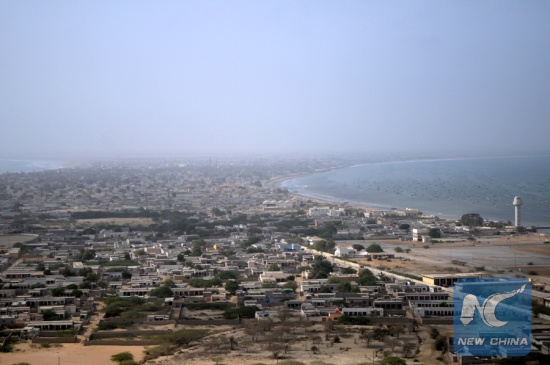
Photo taken on July 2, 2016, shows view of the city near Gwadar Port in southwest Pakistan. (Xinhua/Ahmad Kamal)
Some 60 countries are along the Belt and Road, accounting for 60 percent of the world population, 30 percent of the world gross product, 40 percent of the world trade, and more than 50 percent of the population under the extreme poverty line.
The Belt and Road Initiative is set to promote win-win cooperation for shared development and prosperity, peace and friendship, through enhancing mutual understanding, trust, and exchanges. The initiative advocates peace and cooperation, openness and inclusiveness, mutual learning and mutual benefit. It promotes cooperation in all fields, and works to build a community of shared interests, destiny and responsibility featuring mutual political trust, economic integration and cultural inclusiveness.
On the other hand, the 2030 Agenda for Sustainable Development, which was endorsed and launched at the UN Summit for Sustainable Development in 2015, has charted a sustainable development path for the world in the next 15 years.
The 2030 Agenda includes 17 Sustainable Development Goals (SDGs) and 169 targets, which are integrated along the three dimensions of sustainable development, namely, economic, social and environmental. It is an unprecedentedly ambitious, universal, and overarching Agenda.
"At the core of the Agenda is the determination by all the member states to eradicate poverty and hunger in all their forms, which is within the reach of this generation for the first time in human history," Hong said.
PRIORITY AREAS
The 2030 Agenda has set 17 Sustainable Development Goals (SDGs) with 169 targets, and also includes, as its integral part, the Addis Ababa Action Agenda of the Third International Conference on Financing for Development, he said.
In contrast, the Belt and Road Initiative has identified five priority areas -- policy coordination including building a multilevel intergovernmental macro policy exchange and communication mechanism, coordinating economic development strategies and policies, working out plans and measures for regional cooperation and providing joint policy support for the implementation of practical cooperation and large-scale projects, he said.
At the same time, the UN agenda and the Chinese initiative also share the similar vision in improving infrastructure, fight against poverty and prevention of diseases such as AIDS.
The other priorities of the Chinese initiative also include unimpeded trade, the financial integration and people-to-people bond, he said.
Unimpeded trade includes improving investment and trade facilitation, removing investment and trade barriers and ensuring the implementation of the World Trade Organization (WTO) Trade Facilitation Agreement; expanding mutual investment in such areas as agriculture, both conventional and renewable energy, information technology, biotechnology, new materials and other emerging industries, he said.
Financial integration includes building a currency stability system, investment and financing system and credit information system in Asia, he said.
The Asian Infrastructure Investment Bank and BRICS New Development Bank, which were under the Belt and Road Initiative, are already in operation, he said. "This priority area also includes strengthening financial regulation cooperation and coordination, improving mechanism of addressing cross-border risks and crisis, and encouraging commercial equity investment funds and private funds to participate in the construction of key projects under the Belt and Road Initiative."
People-to-people bond includes promoting cultural and academic exchanges, personnel exchanges, media cooperation, youth and women exchanges and volunteer services; expanding tourism; sharing epidemic information and exchanging of prevention and treatment technologies; increasing cooperation in science and technology by establishing joint labs, international technology transfer centers; and advancing cooperation on youth employment, entrepreneurship training, vocational skill development, social security management, public administration and management, he said.
"Each of the Belt and Road Initiative's five priority areas can find its direct or indirect link to the achievement of the 17 SDGs," he said.
"The scale and ambition of this Agenda requires a revitalized Global Partnership to ensure its implementation," he said. "This Partnership will work in a spirit of global solidarity."
"It will facilitate an intensive global engagement in support of implementation of all the Goals and targets, bringing together governments, the private sector, civil society, the United Nations system and other actors and mobilizing all available resources," he said.


















































